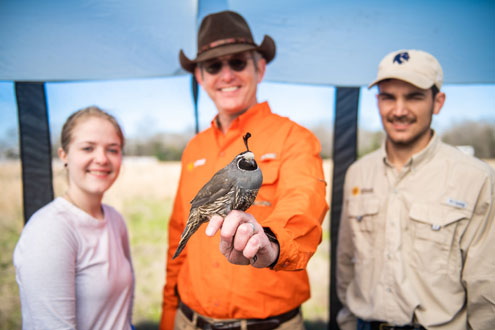Commerce, Texas -- Texas A&M University-Commerce is poised to become a national leader in gamebird research with the future completion of the proposed agricultural education complex.
Texas A&M University System Chancellor John Sharp expressed optimism for the potential of the complex’s facilities that will be dedicated to quail research.
“More birds, of course, is great news for hunters like me, but increased quail populations also means more opportunity for hunting-related businesses to thrive in Texas,” Sharp said.

In October 2021, the Texas Legislature approved a bill that included nearly $45 million earmarked for a new ag complex at A&M-Commerce. Randy Harp, Ph.D., dean of the College of Agricultural Sciences and Natural Resources at A&M-Commerce, touted the impact of the planned facility on agricultural education in the region.
“These facilities will be transformational for our university and for East Texas,” Harp said. “The value of education, both teaching and research, will be immeasurable for our students for many years to come.”
One of the most critical aspects of the new facility will be its research capabilities. A new National Laboratory for Gamebird Research will be housed in the complex.
According to Kelly Reyna, Ph.D., current director of The Quail Research Laboratory at A&M-Commerce, the national research laboratory is poised to become a leading force in sustaining gamebird populations.
“The main purpose of the National Laboratory for Gamebird Research is to foster sustainable gamebird populations through innovative research, education and outreach,” Reyna said. “Our building, research and educational experiences will tell the story of the national gamebird decline and how we can join together to restore them. We are dedicated to facilitating the grand return of gamebirds.”
According to Reyna, the national laboratory will include a state-of-the-art research laboratory, a modern quail production facility, and a gamebird education center for classes, conferences, and public outreach, along with numerous outdoor education stations and nature trails.
The laboratory will provide the necessary tools to research ways to stop the quail decline, which has seen an 80% drop in Texas since the 1960s.
“The new facilities will allow us to look at the impacts of stressors like extreme climate, pesticides and nutrition on chick development and adult health across multiple generations,” Reyna said. “We will also be able to recreate environmental conditions in the laboratory and directly observe how stressors impact quail and other gamebird populations across multiple years. This will further our knowledge of gamebird population dynamics and sustainability, and help us develop solutions to mitigate these stressors.”
Quail are an “umbrella species,” meaning that they indicate the health of all other grassland species. Research suggests that their rapid decline is indicative of instability and deterioration of Texas agricultural communities, resulting in habitat loss and fragmentation. On a national scale, overhunting is not the leading cause of the population decline; rather, it is the loss of habitat coupled with an increased frequency of extreme climate that has hit quail the hardest.
In an economic sense, quail hunters each spend approximately $8,800 per year on things like food in local restaurants, lodging, sporting goods, hunting licenses and more. Quail hunting is part of a $2 billion annual upland gamebird industry. The quail decline has, in turn, resulted in millions of dollars in losses for the Texas economy.
Learn more about A&M-Commerce quail research at tamuc.edu/Quail.